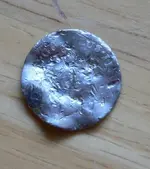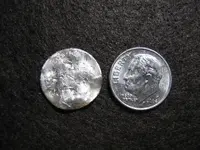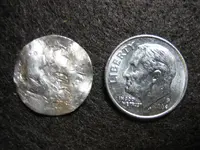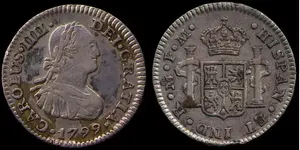Hi Golden 1. I think its a 1/2 Reale, which could have been made in Mexico. Its a pity that so little of the letters cannot be read.
A 1/2 Reale is 17.7mm, and a dime is 17.91mm, so that's close enough. Here is a photo of how it could have looked. It could have been made in Mexico City also.
About the marks on the coin. Although I think also like you, it could be teeth marks, I am not sure because its a silver coin, and not such an early coin either. It has been seen that for instance an Obol, a small light (.7g) silver coin from about 5 BC, has dents on the center of the head and owl, and they are though to be teeth marks. This happened because back then small coins (before the invention of pockets) were often carried in the mouth. Also the silver coins back then were purer than in later years. Because people saw that the coins wore down very quickly they started to make the silver coins harder (by adding copper or other hard metals for instance).
I looked around and found some interesting thoughts about people biting on coins (various comments)
For biting of coins
-I have seen larger silver coins with teeth marks ans holes, I was told that it was a popular teething ring for baby's cutting new teeth to have.
-Gold is softer than teeth, so sinking incisors into the precious metal can reveal the real thing, but coins are generally harder and teeth marks damage their value.
Against biting of coins
- About the 1937 Australian Silver Crown Sterling Silver (.925 silver). The large size and weight, an open design and a clumsy manufacturing process combined to make the Australian crown notorious for bag marks, dings and rim nicks. After striking, the coins were transported by a conveyor belt and dropped into a collection bucket. There are numerous examples of coins which display a neat row of tooth marks imparted by the reeded edge of another crown. Finding a 1937 or 1938 without any marks at all is very, very rare if presented with an example within your means, it would be a great addition to any collection.
-The oldest way to check if the coin is real was simply biting it - please note, I don't recommend doing it, but rather just mention it. You must have seen it in movies about old times, treasure hunters, and pirates. It may seem odd but in fact, there is a very rational explanation for it. Gold is very soft metal, comparing to some base metals, such as copper or bronze for example, and biting a real gold coin would leave some teeth marks or at least leave a feeling that it's biteable. Again, I would not advise testing fake gold coins this way for two reasons: if it's a fake, you may break your teeth, and if it's a real thing, you may ruin it by biting (and possibly break your teeth anyway).
Another way to check if the coin is a fake is to listen how it jangles. Fake gold coins sound dull and boring according to people who have very good ears. Again, this test may rather be not always reliable and you would have to spend years listening to real and fake gold coins to learn how to tell them apart.
- I used to think this. Then I read that people would bite on a gold coin to test if it was lead covered with gold leaf. Lead is the only common metal anywhere NEAR the density of gold and it is very soft. If the bite made a mark, it was fake. It is true that gold is also very soft as a pure metal, but gold coins minted for circulation were never pure gold - they are always alloyed with silver because pure gold will wear too fast. So a true gold coin alloyed with silver is not going to show a bite mark. The best way to test gold is to measure its density. There is no way to fake that because anything more dense than gold is also more rare. Unfortunately, the density of silver CAN be faked using lead
inserts. I don't know any easy way to tell.
And FINALLY, if you want to bite a gold coin, and have gold crowns in your mouth, watch out for this!!!!!
"If a person with gold teeth bites a gold coin, a fish wizard will appear wearing the cloak of destiny and carrying a bag of dust. the fish wizard will knock on the person's forehead three times, turn in a complete circle, and grant one wish, which cannot be used for any material gain. The person must take a shower within 24 hours for the wish to come true. If during that time they fall asleep and dream of fish, the wish will be granted tenfold."












